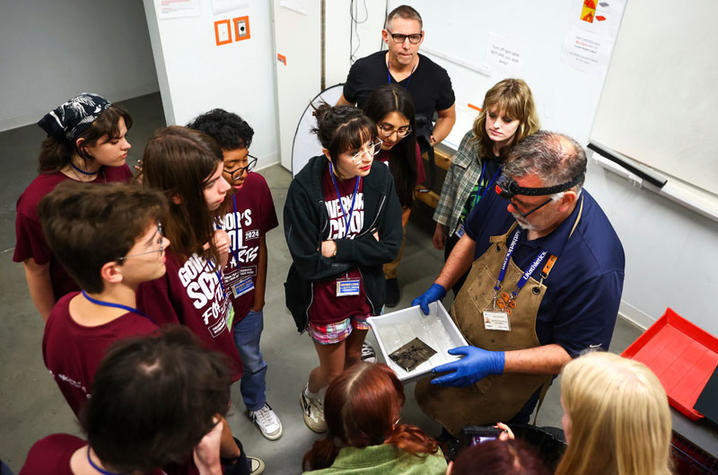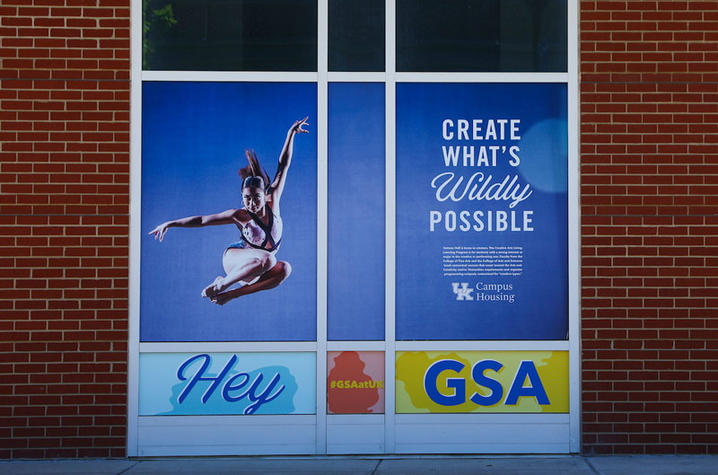Even years later, GSA alumni reflect on lessons learned
LEXINGTON, Ky. (July 5, 2024) — When he was a high school student attending Kentucky’s Governor’s School for the Arts (GSA) in 2001, Aaron Bowling had his eyes on studying drama. Unlike many of his peers, he did not want to put blinders on to the wider world of art in favor of his own chosen field.
“(At GSA) they have these activities called ‘smorgs’ where you try out things that are happening in other disciplines,” Bowling said. “So, I personally took advantage of a lot of those opportunities to learn about creative writing and vocal music and visual art.”
Those happen to be artistic disciplines that apply to his current job as production manager for the UK Opera Theatre program in the School of Music. Bowling, who earned bachelor’s degrees at the University of Kentucky in fine arts (theater performance) and Spanish, says opera as a genre requires the contribution of so many varied artistic disciplines. It is, as the prolific German opera composer Richard Wagner expressed it, gesamtkunstwerk — a “total work of art.”
Bowling is one of several UK faculty and staff members who are alumni of the 21-day intensive arts experience for high school students.
This summer GSA is in full swing on UK’s campus, the sixth year the university has hosted the event. Its first three-week session ended last week. The second session starts July 7 and runs through July 27.
GSA offers high-quality instruction in nine disciplines: architecture and design, creative writing, dance, drama, film and photography, instrumental music, musical theater, visual art, and vocal music.
Hannah Smith is manager of the fabrication lab at UK’s School of Art and Visual Studies and is a lecturer in digital design and 3D fabrication. Originally from Goshen, Kentucky, in Oldham County, Smith attended GSA in 2012 as a visual artist. She says being exposed to so many visual arts disciplines has been an important influence in her life as a professional artist and teacher.
“It instilled in me this the significance of interdisciplinary work within visual arts and how that breeds innovation, and that is really the reason why I make the work I make today,” Smith said. “I truly do not think I would be working in sculpture were it not for the Governor’s School for the Arts.
“Before that, I just told people I was a painter. I said I was a painter for like the first 14,15 years of my life and after GSA, it radically changed that perspective.”
Mark Mozingo, a marketing and promotions specialist in the College of Fine Arts, described his experience at GSA as “eye-opening.” He attended GSA in 2001 studying drama. Following graduation from George Rogers Clark High School in Winchester, Kentucky, he attended Wright State University, completing a bachelor’s degree in fine arts in 2005. From there, he worked professionally in regional theater, off-Broadway, film and television and on cruise ships until returning to Kentucky in 2014, cofounding AthensWest Theatre Company with Bo List. Mozingo credits GSA for stoking his creativity and helping launch his career.
“GSA was the first time I was surrounded by other people my age who were just as passionate about their respective disciplines as I was about acting,” Mozingo said. “Like a lot of students who were coming from smaller areas in Kentucky, it was sometimes isolating feeling like you were the only person your age interested in your art in a small town. And now suddenly there were 240-plus people around your age who were not only interested, but also very much into their own respective disciplines.”
Jennifer Campbell, Ph.D., is an associate professor of music theory and composition in the UK School of Music, but in 1992 she was one of eight student pianists from across Kentucky selected for the Governor’s School for the Arts. Though her primary focus at UK is on 20th century American composers, the Taylor County native still plays piano for enjoyment, to demonstrate examples in class and to accompany other musicians.
Campbell described GSA as integral to learning how to take charge of her career in music. She says she had to make a concerted effort to find opportunities to better herself.
“I realized that I had to make my own appointment and walk into the guidance counselor’s office myself in order to ask the question, ‘What programs can I apply for that will help me grow in my areas of interest?’” she said. “When I heard about GSA as a sophomore, I became determined and competitive in pursuit of attending it.”
The application alone was a learning experience for Campbell. It forced her to learn about the audition process most professional performers must go through to get jobs. She reevaluated not just how much she was practicing piano, but also the quality of her practice sessions, improving her technique by playing scale exercises. She developed interview skills and played mock auditions.
“I would suggest my application to GSA represented the first time in my life that I wanted to win something so intensely,” she said, “and the application process itself taught me what type of drive it takes to find opportunities in life and to achieve them.”
Positive influences, mentors
The GSA experience puts Kentucky high school students in front of some of the Commonwealth’s most talented artists.
Mozingo was effusive in his praise of then GSA director Frank X Walker, former Kentucky Poet Laureate.
“I had never really been exposed to poetry before coming to GSA. So, when he brought the Affrilachian Poets in to read their work, I was fascinated,” Mozingo said. “I was impacted by a lot of the nondrama faculty the most, just being inspired by their passion and artistic work in their respective fields made me very proud to be from Kentucky.”
Campbell recalls studying at GSA with Richard Scott, who, at the time, was on the Murray State University faculty and was a veteran GSA instructor.
“He was an engaging, patient and inspiring instructor,” she said. “He was one who was able to reach students with wildly divergent music backgrounds and push all of us forward to better our craft.”
Bowling remembered two instructors from his time at GSA, Tim Soulis and Sully White, who made a lasting impression on him.
“Probably the most important lesson they taught me was that you really have to love (theater) to stay in it,” Bowling said. “If you don’t love this, if you can see yourself doing anything else in the world, do that instead. And that’s the No. 1 piece of advice that I give to students. The people who do this for a living are the people that can’t see themselves doing anything else.
“So, I knew this is what I should be doing and where I should be,” he said. “That was excellent advice for me, and I try to pass it on as often as humanly possible.”
The mentoring at GSA sometimes lasts beyond the three-week program. Smith said one of her instructors in 2012, Susan Harrison stands out in her memory as influential on Smith’s own career.
“She’s been a continuous mentor figure for me throughout my life,” Smith said. “She’s the person that exposed me to print — my very first print teacher ever. But she also has sculptural elements to her own printmaking practice.”
Smith says seeing those 3D elements applied to printmaking opened a world of creative possibilities in her own practice.
“I think seeing the way she worked freed me up to explore the potential of something nontraditional in my own work,” she said.
Lifelong friends, professional connections
Although high school students are probably not thinking about networking, Bowling says at GSA they are doing it whether they know it or not.
“You never know what the person sitting next to you at GSA as a 17-year-old is going to be doing in 20-something years,” he said. “I went in 2001 and 23 years later I’m still in contact with people that I went to GSA with, and they’re now some of the leading arts organizers around the country.”
Among Bowling’s GSA classmates was Nick Covault (also a UK alum), who served as GSA director for several years before being promoted to vice president of education and community at Kentucky Performing Arts, the organization under which GSA operates.
Smith made friends with Chelsea Harris, who is now education director at Louisville’s Speed Art Museum.
“She’s one of my best friends to this day,” Smith said. “And she has a really amazing career in the arts.”
Returning as alumni
Many GSA alumni, once they have completed the 21-day program, make it a personal goal to return as either faculty or staff members.
Mozingo served as a residential assistant (RA) in 2003 and ’04.
"Those were really amazing experiences,” he said. “GSA is a great network to be a part of.”
Like Mozingo, Bowling was an RA in 2003 and ’04.
“As soon as I had gone through the program (in 2001), I was asking them, ‘When can I work here?’” Bowling said.
During his time on staff, Bowling noticed students who were more introverted, and as a result were not being approached to participate actively in social activities.
“I tried in as many ways as possible to focus on those individuals and try and make sure they had as good of a time as possible, and get the most out of their experience because the people who are like me that are very engaged and outgoing, you don't really need to worry about them,” Bowling said. “They’re gonna take care of themselves.
“And probably my proudest moments in that time were when students reached out to me after GSA,” Bowling added. “They told me they weren’t sure if they should have gone, weren’t sure if they belonged and the fact that I sought them out regularly and said, ‘What are you doing?’ or ‘Here’s an opportunity you didn't know about.’ I just helped guide them to opportunities they wouldn’t have done otherwise, and they thanked me for that because they probably would not have enjoyed the experience as much otherwise.”
Smith was invited back to GSA to teach visual art, which she has done for three years. Being asked to serve as an instructor was an honor, she says, and it allowed her to serve alongside people she considers some of her mentors.
“It’s just a really incredible full-circle moment for me to work with these people who I’ve looked up to for so many years, and to also continue learning from them,” she said. “I don’t think you ever really stop learning.”
As the state’s flagship, land-grant institution, the University of Kentucky exists to advance the Commonwealth. We do that by preparing the next generation of leaders — placing students at the heart of everything we do — and transforming the lives of Kentuckians through education, research and creative work, service and health care. We pride ourselves on being a catalyst for breakthroughs and a force for healing, a place where ingenuity unfolds. It's all made possible by our people — visionaries, disruptors and pioneers — who make up 200 academic programs, a $476.5 million research and development enterprise and a world-class medical center, all on one campus.






